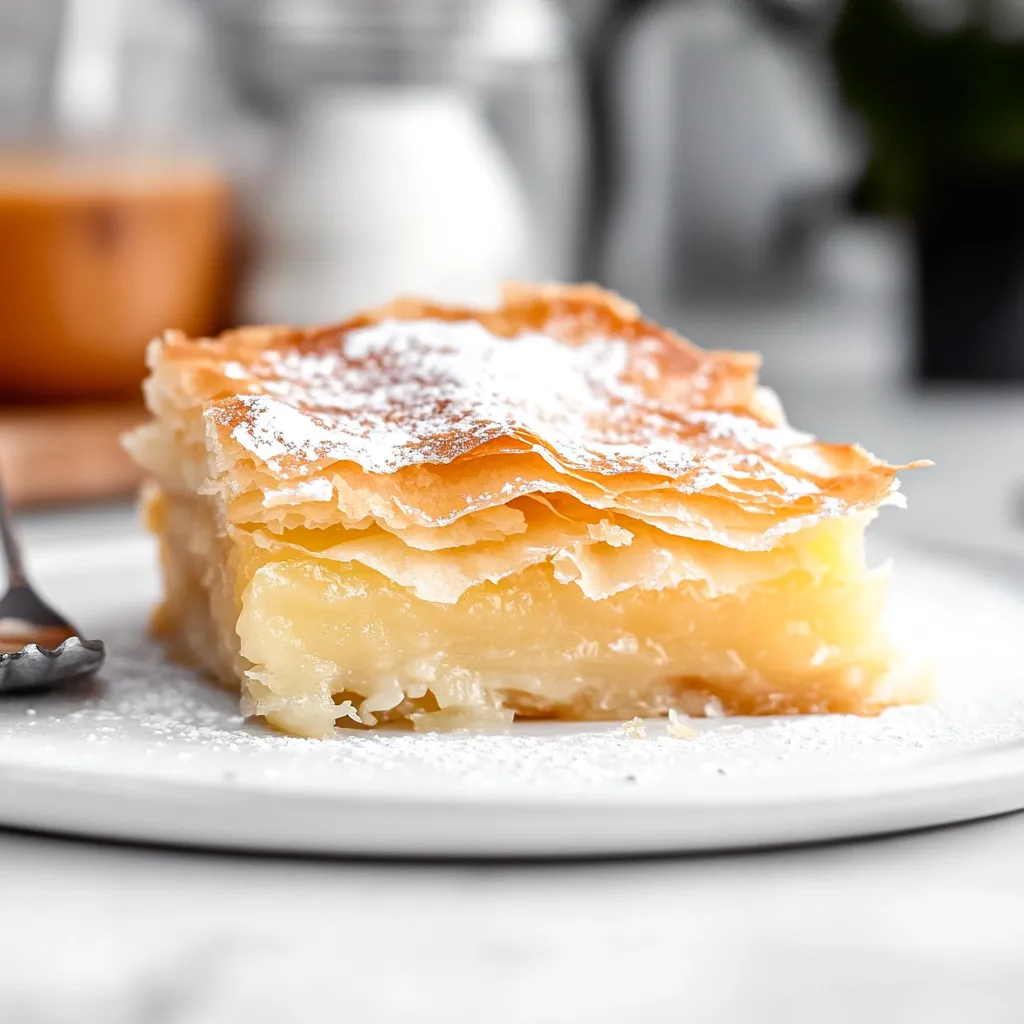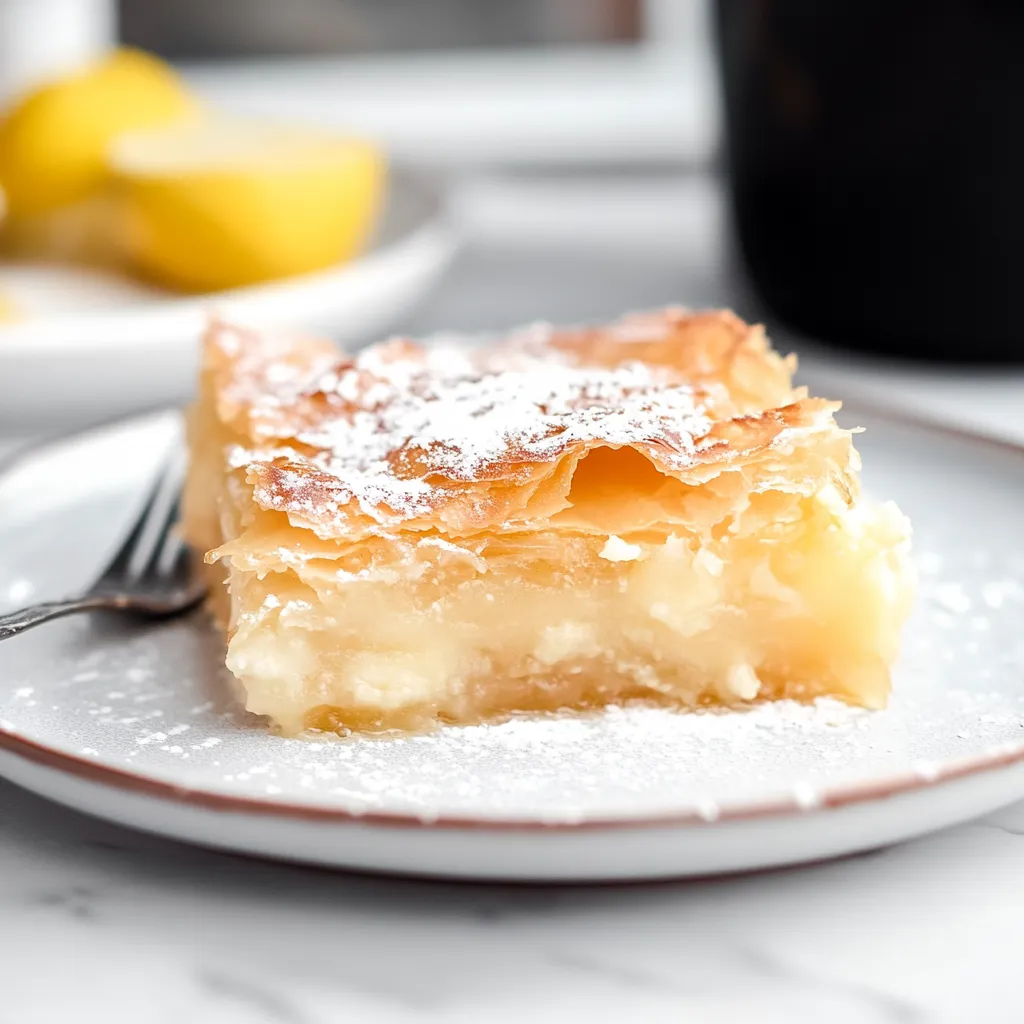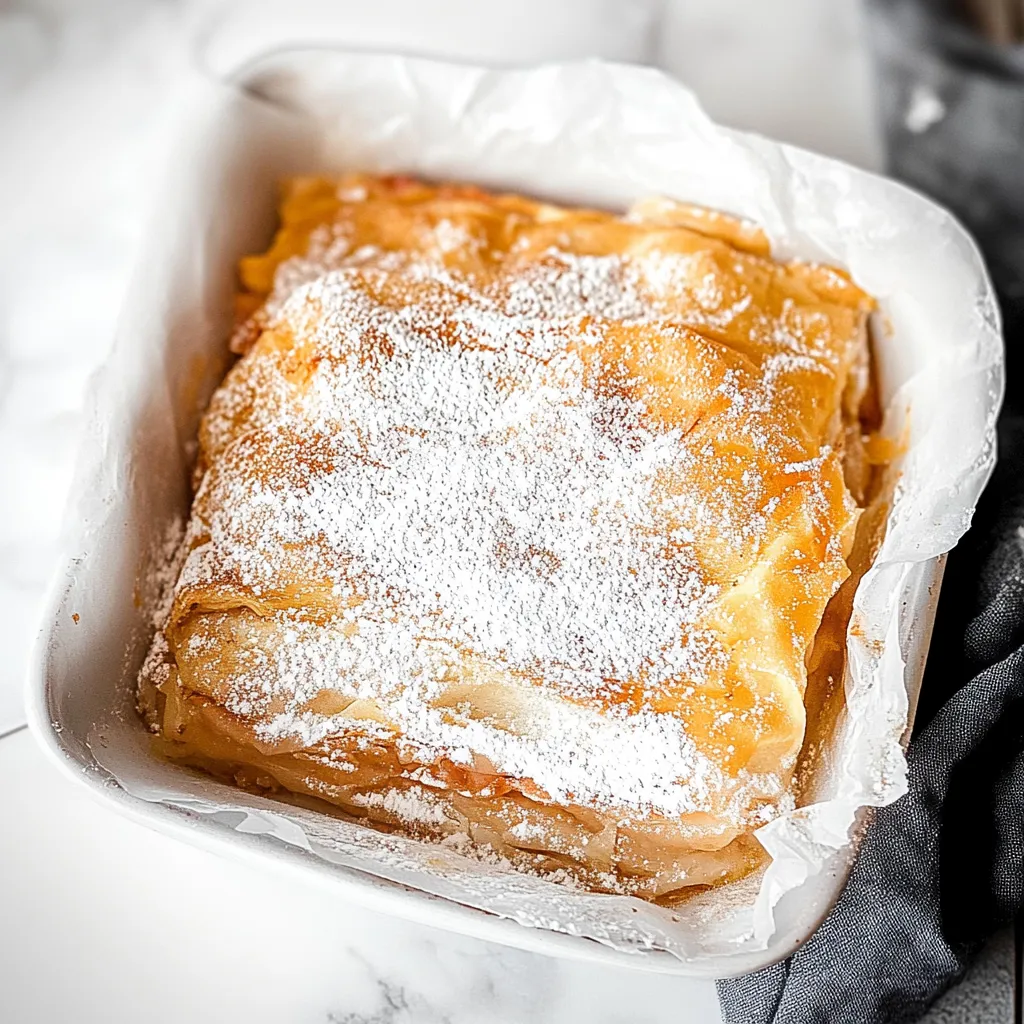 Pin it
Pin it
This flaky Greek filo treat filled with smooth semolina custard is my top pick for weekend morning indulgence. The magic of bougatsa lies in how those crispy outer layers wrap around that silky-smooth center—it'll make you feel like you're sitting at a little café by the water in Thessaloniki.
I first fell for bougatsa as a kid traveling with my family in Greece. We got hooked on grabbing those warm, cinnamon-sprinkled squares every morning, and now when I make them at home, I can almost smell the sea air and hear the busy market sounds.
Ingredients
- Large eggs: They build the custard's structure and add richness—let them sit out to reach room temp for best results
- Butter: Brings luxury to both the custard and filo sheets—grab unsalted so you can control the taste
- Sugar: Adds just enough sweetness without going overboard—feel free to tweak slightly
- Milk: Forms the custard foundation—full-fat gives the richest outcome
- Fine semolina: Gives the custard its signature slight texture—hunt for the smallest grain you can find
- Vanilla extract: Brings lovely background flavor—real extract beats imitation every time
- Filo sheets: Create those must-have crispy layers—thaw them slowly in your fridge overnight
- Melted butter: The secret to getting golden, crunchy filo—don't be shy when brushing
- Icing sugar: Sprinkled on top for that classic finish—add while still warm
- Cinnamon: Brings that familiar gentle spice note—Ceylon type offers milder flavor
Step-by-Step Instructions
 Pin it
Pin it
- Get Your Eggs Ready:
- Beat those eggs in a small bowl until they're foamy and fully mixed. You'll need them handy and ready to go once your milk mixture heats up, so keep them within arm's reach of your stove.
- Start Your Custard:
- Grab a medium pot, put it on medium heat, and throw in your quarter cup of butter with the sugar. Keep stirring until all the butter melts and mixes with the sugar—about 2 minutes. Don't let it brown. Pour in your milk, fine semolina, and vanilla while still stirring. Turn the heat down to medium-low so nothing burns. The slow cooking lets the semolina soak up liquid without clumping.
- Mix and Thicken:
- When your milk mix is hot but not bubbling, slowly pour in those beaten eggs with one hand while whisking like crazy with the other. This stops the eggs from cooking into scrambled bits. Keep whisking for 4-5 minutes until it thickens enough to coat a spoon like pudding. Take it off the heat right away and let it cool a bit while you deal with the filo.
- Set Up Your Filo Bottom:
- Heat your oven to 350°F and brush your 8x8 baking pan all over with melted butter. Lay down your first filo sheet with the extra hanging over the sides. Brush it completely with butter, getting all the corners. Add another sheet at a slight angle for better coverage. Brush with butter again. Keep going until you've got 5 buttered sheets as your base.
- Pour In The Filling:
- Dump your slightly cooled custard into your filo-lined pan and spread it out evenly. Fold those hanging filo edges over the custard to partially cover it. Brush these folded parts with more butter so they'll get crispy while baking.
- Build Your Top Layer:
- Take another sheet of filo and loosely bunch it up as you place it on top of the custard. This bunching creates awesome texture. Brush butter into all those nooks and folds. Do the same with one last sheet of filo, scrunching it artistically and soaking it with butter. These top sheets will turn amazingly crispy and golden.
- Bake Until Beautiful:
- Stick your bougatsa in the hot oven for about 40 minutes, or until the top turns deep gold and the edges get crispy. You might want to turn the pan halfway through for even browning. The custard should mostly set but still have a tiny wobble when you gently shake the pan.
- Add Final Touches:
- Pull it from the oven and let it sit for 10 minutes. This short cooling helps the custard firm up while keeping everything warm. Shower it with icing sugar and cinnamon for that classic look. Cut into squares and serve while warm for the real deal experience.
My grandma always told me to cool the custard a bit before putting it on the filo so the sheets wouldn't get soggy. She'd talk about making bougatsa for my grandpa every Sunday morning after they got married in Athens. Those kitchen stories make this treat extra special to me.
Make-Ahead Tips
Bougatsa tastes best right out of the oven when the outside is super crispy and the inside is still warm. But you can make the custard filling a full day ahead and keep it in the fridge with plastic wrap pushed right against the surface so it doesn't form a skin. When you're ready to use it, warm it gently in a pot just until it's pourable, then build your bougatsa with the filo. This saves tons of time on the day you want to eat it.
Regional Variations
This recipe shows off the sweet custard version of bougatsa that folks love in Thessaloniki, but other parts of Greece do it differently. Some areas fill theirs with mizithra cheese (it's a bit like ricotta) or even seasoned ground meat. The sweet kind always gets a dusting of powdered sugar and cinnamon, while savory ones might have sesame seeds sprinkled on top. Every local will swear their hometown version is the true authentic one!
Serving Suggestions
In Greece, people usually cut bougatsa into squares and eat it for breakfast with strong Greek coffee. For the full experience, serve yours slightly warm with fresh powdered sugar and cinnamon on top. If you want a bigger breakfast, add some fresh fruit and Greek yogurt on the side. For dessert time, try adding a small scoop of vanilla ice cream or drizzling some honey over top to make it extra special.
 Pin it
Pin it
Every bite of this bougatsa brings Greece right to your kitchen, wrapping that creamy custard in layers of golden, flaky goodness.
Frequently Asked Questions
- → Can I make Bougatsa ahead of time?
You can definitely prep Bougatsa a day early. Once it's baked, let it cool all the way, then wrap it up and stick it in the fridge. Warm it back up in your oven at 300°F for about 10-15 minutes and add fresh sugar and cinnamon right before you serve it. But remember, it's always tastiest when fresh and the filo is super crispy.
- → What is semolina and can I substitute it?
Semolina is a gritty flour from durum wheat that gives your custard its special feel. For real Bougatsa, you really need semolina. If you're stuck, you might try farina or cream of wheat instead, but know that your dessert won't have that authentic Bougatsa taste and texture.
- → Why is my filo dough tearing?
Filo gets dry super fast in open air. Always keep the sheets you aren't using right now under a slightly wet kitchen towel. Make sure your filo has completely thawed if it was frozen. Be gentle and work fast so it doesn't rip.
- → Can Bougatsa be frozen?
You can freeze Bougatsa after baking it. Let it cool completely first, then wrap each piece in plastic and foil. It'll stay good in the freezer for up to a month. When you want some, let it thaw in your fridge overnight and warm it up in a 300°F oven. Don't forget to add fresh sugar and cinnamon before eating.
- → Is Bougatsa served hot or cold?
People usually eat Bougatsa warm or at room temp, never straight from the oven because the custard needs time to firm up. Don't serve it cold from the fridge either. When it's just the right warmth, you'll get to enjoy both the crunchy filo and the smooth custard at their best.
- → Can I make a savory version of Bougatsa?
You bet! While this one's sweet, many Greeks love savory Bougatsa too. For a savory twist, skip the sugar and vanilla, and fill it with a mix of feta cheese, eggs, and fresh herbs like mint or parsley. You'll cook it the same way as the sweet version.
